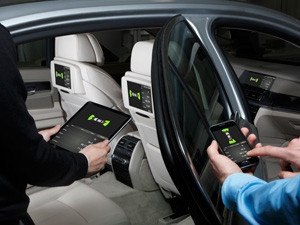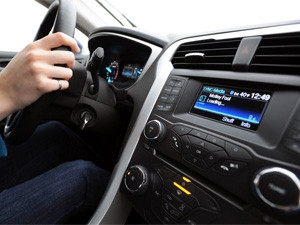
Media companies like Apple and Google are eager to expand their ecosystems, but have had limited traction doing so beyond laptops and phones. They're hedging their bets on your home and entertainment area, but the lowest-hanging fruit - at least regarding potential mainstream adoption - is the car. In recent months, there's been a lot of noise around the idea of the connected car, primarily through expanding smart-device ecosystems into the head unit displays on car dashboards, a.k.a. telematics.
Car manufacturers are also keen. It's a sensible evolution for car infotainment and telematics systems to connect with the internet. Smart devices already provide services that customers would anticipate and mobile networks, particularly LTE, make connectivity practical. There are also other benefits, such as crash assistance, vehicle tracking and improved navigation services.
At its simplest level, a connected car has a data connection. So a navigation computer with a GPS chip wouldn't qualify, but it is the precursor. The head unit - the screen and such in the dashboard - that it cultivated is becoming a battleground for the internet giants. Yet despite such obvious merits and strengths, this union is already onto a rocky start.
Technology follows a well-worn path where software makers dictate terms to hardware manufacturers, so device builders such as Samsung and Nokia either toe the line or get left behind. This already doesn't make for the happiest of partnerships, because software holds the balance of power and hardware companies often find themselves playing second fiddle. But at least there's a certain mutual reliance and matching development rate.
Goliath vs Goliath
Cars are different. They don't benefit from such a symbiosis - you don't need Android or iOs for your car to function and most head units suffice with a few services such as mapping software. Nor do they evolve at the same pace. While gadget creators bank on the next software iterations as a roadmap for progress, vehicle development is on a different timescale. So other than the head unit, there's no natural nexus here.
"Google or Apple may try one thing, then something else," says Antti Aumo, marketing director of the Car Connectivity Consortium. "But a car takes five years to develop; it's then driven for ten. That's a huge difference. Yet car companies have seen how technology changed other industries, and they don't want to be caught off-guard."
As a result, you have two drivers trying to grab hold of the same wheel. But it's unlikely that car companies will take the back seat, says Rudi Venter, product manager for Audi SA: "There would have to be a fundamental shift on how people use their vehicles before a car company would cede control to a third party around driving principles."
It's currently unclear where Apple or Google stand on the matter, but support for device agnosticism and open standards is quite strong among motor companies.
He adds that when it comes to infotainment and such, there's more of an acceptance to rely on external companies. But car manufacturers have legal responsibilities ? safety and driver laws can hold the manufacturer responsible. As Aumo puts it: if someone drives their car off the road while reading Facebook, who's to blame: the car or the software?
"If they were on their smartphone, it's not the car's fault. But what if they were reading status updates on the dashboard?"
Distraction value
Driver distraction is a real concern, although you'd be surprised by the dearth of factual conclusions around the topic. Still, car companies want to avoid adding to driver workload. The problem is that smart devices and their ecosystems are practically built on distraction value.
Thus apps have to adhere to strict protocols regarding their appearance and interaction. Apple solves this by hand-picking developers and Google offers development templates. MirrorLink, the open telematics standard supported by the Car Connectivity Consortium, is likely the closest to a solution. Apart from facilitating connections between the car and devices, it also translates legislation requirements into plain English for developers and helps vet applications for car use. A MirrorLink certification is an assurance of meeting legislative standards and is apparently gaining a lot of support in the industry. Aumo says that around 70% of major car and device manufacturers back MirrorLink.
Car companies can use MirrorLink specifications to approach developers directly too, which is an important factor as auto brands differentiate themselves through the head unit experience. QNX, the BlackBerry-owned leader in embedded systems, also gives the development choices to the manufacturers.
"Support for standards has helped make the QNX platform popular among automakers, for the simple reason that it's easy to port third-party applications and services to our platform," says Tina Jeffrey, automotive product marketing manager at QNX Software Systems. "It also offers assurance to customers concerned about vendor lock-in."

That is a particular concern: car brands don't want to lose potential sales because client phones won't match the infotainment system. It's currently unclear where Apple or Google stand on the matter, but support for device agnosticism and open standards is quite strong among motor companies.
Stacking up
Allegiances are far from settled. Almost every major car brand belongs to both a connected car consortium and funds development of proprietary systems. BMW's ConnectedDrive is one of the latter and takes it to the most extreme: while it supports device connections, the system has its own data SIM card and operates independently from a smartphone. Going proprietary was certainly the expensive route, but BMW was able to add services such as crash assist and an on-call concierge to recommend places in your immediate vicinity. It also offers services through subscriptions, indicating new revenue streams for manufacturers.
It is Android Auto and Apple's CarPlay that actually stand more isolated. For one, they're relative newcomers: QNX has a major foothold in embedded devices and Windows Embedded Automotive, used by the long-running Ford Sync system, has been around since 1998. Both also back the MirrorLink standard. But the waters are still incredibly murky.
"As for connecting cars and smartphones, there will be no winner in the foreseeable future," says Jeffrey. "Expect to see an ongoing mix of standard and proprietary models."
One solution often touted is that of multiple stacks, which means cars would ship with more than one system on board. As yet, no manufacturers have committed exclusively to a platform and some are already betting on several horses. Volvo is implementing both Apple and Google systems, because neither will support each other. Honda has announced cross-compatible systems in its cars by 2015.
It may not even be a manufacturer's concern: Subaru has begun shipping MirrorLink-compatible systems in its vehicles, yet is not involved with MirrorLink. Not that it needs to be - MirrorLink is open for anyone to use. But in this case, it was the head unit manufacturer that chose the standard - Subaru is basically just along for the ride.
There are numerous other issues that surround the connected car, like security and the Internet of Things. But whatever the outcome, the connected car is going to be a work in progress for quite some time - and consumers aren't likely to force quick change.
"Most car consumers are focused more on driving," says Venter. "We haven't really seen a demand for a car that is more connected than you see today. The technology will have to become affordable and standardised before people will appreciate it."
First published in the September 2014 issue of ITWeb Brainstorm magazine.
Share